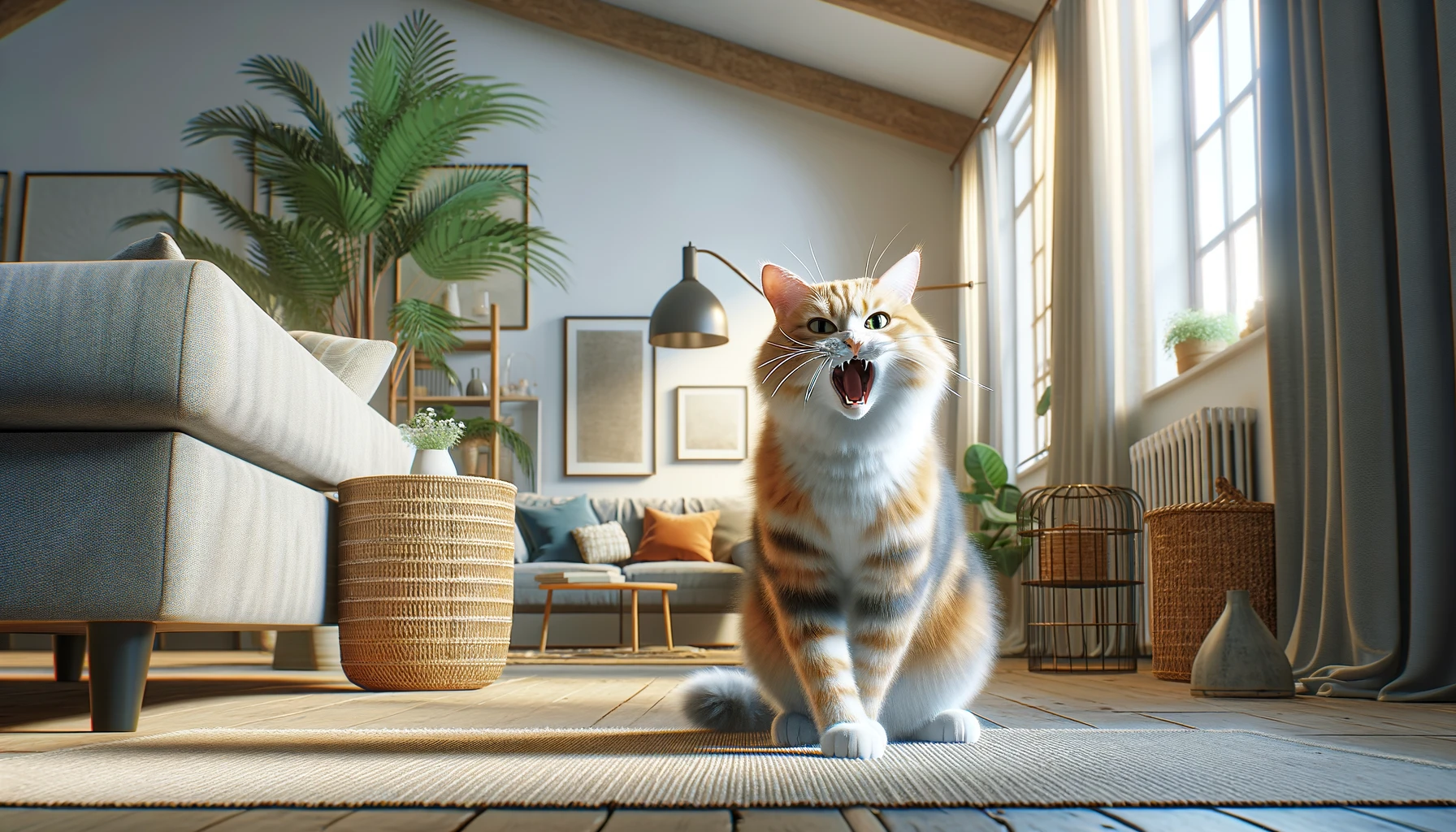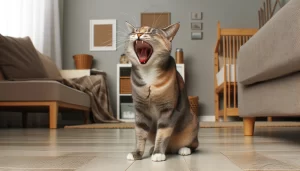In the quiet moments just before dawn or in the peaceful twilight hours, you might hear a sound that’s both familiar and unsettling: the low, rumbling growl of a cat. This sound, often heard less frequently than the cheerful purr or the demanding meow, carries with it a wealth of meaning and emotion. Why do cats growl? This question captures the attention of pet owners worldwide, as understanding this aspect of feline communication can significantly enhance the bond between humans and their feline companions. Growling is a multifaceted behavior that serves as a window into the complex emotional world of cats. It’s a form of communication that, when decoded, reveals much about a cat’s feelings, needs, and concerns. As pet lovers, delving into the reasons behind cat growling not only satisfies our curiosity but also empowers us to provide better care, ensure a harmonious living environment, and deepen the affectionate connection we share with these enigmatic creatures.Understanding these behaviors is the first step towards achieving this goal, leading us to explore the natural form of communication that growling represents for cats.
Understanding Cat Growling
Growling is considered a natural form of communication for cats. What starts out as a low, long murmuring can quickly turn into a fierce guttural sound, accompanied by the curl of a lip and the exposing of teeth. This type of sudden aggression in cats can be quite shocking, especially when you’re accustomed to a more gentle companion, it might come as a shock to see that even the most docile cat can exhibit sudden growling behavior under certain circumstances. This shift emphasizes that cats, feeling threatened or uneasy, may express strong emotions, even those who are generally seen as calm. Intimidating as it might be, it is also completely normal. When a cat does begin growling, though, it is up to us to determine the reason behind it and begin taking steps to address the issue if there is one. Sometimes, the simplest solution is to give them a bit of space. Just because a cat is growling or hissing doesn’t necessarily mean there is something significantly wrong. It may be they’re just feeling a little crowded, overwhelmed, or wound up. Giving them a little space may diffuse the situation without you actually having to intervene.
Growling is a common display of dominance. Cats can be highly territorial, and they’re not exactly backward in coming forwards when asserting their dominance. In some cases, growling is simply their way of showing who’s boss. This can be a common issue in multiple cat or pet households, and it isn’t just other animals who run the risk of ending up on the end of a snappy snarl. Even us pet parents can sometimes find ourselves in the feline firing line.
By providing this comprehensive analysis, not only do we offer an in-depth understanding of the various reasons behind cat growling behavior, but we also highlight the importance of taking the right actions when faced with cat growling. From territorial behavior to reactions to pain and discomfort, each reason reveals that cat growling is more than just a simple expression of sound, but a direct reflection of their complex emotions and needs. By giving them enough space, identifying, and addressing the root issues, we can effectively manage cat growling behavior, promoting harmonious living between pets and their owners.
To manage these behaviors effectively, it’s crucial to understand their root causes, which we will delve into in the following section.
Common Reasons for Cat Growling
Cat growling serves as a method for them to communicate their inner emotions, with each growl telling its own story. Understanding these reasons helps us better understand and care for our little furballs.
1. Territorial Behavior:
Cats are innate territorial animals that use growling to declare and defend their territory. When another cat or any intruder enters what they perceive as their domain, growling becomes their warning signal. This instinctual behavior stems from their wild instincts, and even the most docile house cat might display this behavior.
2. Fear and Defense:
Cats growl to express their unease when they feel scared or threatened. This serves both as a defense mechanism and a way to tell potential threats, “I’m ready to fight.” Whether it’s due to strangers, other animals, or unfamiliar environments, growling is their way of trying to protect themselves.
3. Pain and Discomfort:
If a cat growls due to physical pain or discomfort, it is often their way of signaling to us that they need help. Various reasons, from injuries to illnesses, can cause a cat to feel pain. As pet owners, we need to be especially sensitive to these signals and provide the necessary care and treatment in a timely manner.
4. Social Hierarchy:
In multi-cat households, growling may be a way to establish or maintain social hierarchy. Interactions among cats are complex, and they use growling to assert dominance or respond to challengers. This social dynamic requires careful observation by the owner to ensure peaceful coexistence at home.
5. Playful Excitement:
Sometimes, growling is not a result of negative emotions but an expression of excessive excitement. During intense play, cats might growl due to being overly stimulated. Understanding the context of this growling is key, as it does not always signify aggression.
6. Fear, Stress, and Frustration:
Changes in their life, uncertainty in the environment, or even changes in the family structure can induce stress and frustration in cats, leading to growling. As owners, identifying these sources of stress and taking steps to alleviate them is crucial in helping cats adjust and feel secure. When new pets or babies are introduced into the family, the original cat might growl due to stress and frustration caused by changes in the environment, expressing its unease.
7. Defending Food, Toys, and Kittens:
Cats may also growl when they are protecting their food, toys, or kittens. This protective behavior is part of a cat’s instincts, using growling to inform other animals or humans that these resources are theirs. This behavior is especially common in homes with multiple pets. For example, a mother cat might growl when other animals approach her kittens, as an instinctive response to protect her offspring.
In some cases, female cat behavior after spaying may also lead to changes in vocalization, including growling, as they adjust to hormonal changes. This aspect, though not the primary focus of our discussion, contributes to the complexity of understanding feline communication.
By understanding these common reasons behind growling, we can better comprehend the needs and emotional states of our feline friends. Not only does this help us provide better care and support, but it also promotes harmonious living with our pets. As guardians of cats, our task is to listen to their voices, understand their behavior, and respond appropriately to their needs, thereby creating a safe, supportive environment where they feel loved and understood.
In this way, we not only deepen our understanding of cat behavior but also strengthen the emotional bond between pets and their owners, ensuring our furry family members feel happy and satisfied.
Having explored the reasons behind their growling, let us now consider how best to respond to these signals in a way that fosters understanding and trust.
How to Properly Respond to Cat Growling
When faced with a cat’s growling, our instinctive reaction might be confusion, worry, or even fear. However, understanding how to fundamentally comprehend and correctly respond to this behavior is key to building trust and deepening our relationship with our pets.
1. Giving Them Space
When encountering growling, it’s crucial to give your cat plenty of space; keeping a distance is best to avoid further agitation. Observe the cat’s behavior to understand the cause of its growling. Provide a quiet refuge for the cat, giving it its own space, and wait for the cat to seek closeness on its own. Doing so helps to reduce its stress while also protecting its emotional well-being.. Forcing closeness will only exacerbate their fear or aggression, which is vital for maintaining safety between pets and their owners.
2. Observing and Identifying Causes
Try to understand the reason behind the growling. Is it due to a new environment, the proximity of other pets, or are they in pain or discomfort? Accurate observation is the basis for formulating a reasonable response strategy.
3. Providing a Sense of Security
Ensure your cat feels safe. This might mean creating a quiet, comfortable retreat space for them, especially when there are other pets or children in the house.
4. Using a Calm Voice
When communicating with your cat, use a peaceful, soothing tone. Loud or sudden movements may increase their tension.
5. Avoiding Punishment
Never punish your cat for growling. Such actions not only fail to solve the problem but could also harm their emotions and damage your relationship with them.
6. Seeking Professional Help
If growling behavior is frequent and accompanied by aggression, consider seeking help from a veterinarian or an animal behaviorist. They can offer professional advice and intervention measures.
By taking these measures, we can better understand and respond to our cat’s growling behavior and provide a safer, more supportive environment for them in our daily lives.
Understanding and responding to growling are important steps, but preventing such behavior from occurring can lead to even more harmonious relationships.
Preventing Cat Growling Behavior
Understanding and preventing cat growling isn’t just about silence; it’s about fostering a bond of trust and comfort between you and your feline friend. Here’s how to create an environment where growls are rare, and purrs are abundant.
1、 Understanding Your Cat’s Needs:
Every cat has its own set of needs and preferences. Recognizing and catering to these can significantly reduce instances of growling. Provide them with ample space, opportunities for play, and quiet resting areas. Just like us, cats need their personal space to feel secure and respected.
2、 Providing a Sense of Security and Stable Environment:
Stability in their living environment makes cats feel secure. Avoid sudden changes in their surroundings and routine, as these can lead to stress and fear, manifesting in growls. Consistency is key to a calm and happy cat.
3、 Proper Socialization and Early Education:
Introduce your cat to a variety of experiences, people, and other animals early on, but do so gradually and positively. Socialized cats are less likely to feel threatened and, therefore, less likely to growl out of fear or discomfort.
4、 Territory and Resource Management:
In multi-cat households, ensure each cat has access to its own resources—food bowls, water, litter boxes, and sleeping areas. This reduces competition and territorial disputes, significantly lowering the chances of growling.
5、 Health Management and Regular Check-ups:
Regular vet visits are crucial. Many cases of growling stem from pain or discomfort. Early detection and treatment of health issues can prevent pain-induced growling and ensure your cat’s well-being.
Additionally, pet owners often ask ‘why is my spayed female cat yowling?‘ Understanding that spaying can affect your cat’s behavior is crucial for adjusting care and preventive strategies to minimize stress-induced vocalization, including growling and yowling.
6、 Behavioral Training and Positive Reinforcement:
Encourage desired behaviors through positive reinforcement. Rewards and treats can do wonders for behavior modification, reducing the need for your cat to communicate distress or discomfort through growling.
7、 Environmental Enrichment and Stimulation:
Keep your cat’s environment engaging. Provide toys, scratching posts, and interactive activities to keep them mentally and physically stimulated. A bored cat is more likely to exhibit negative behaviors, including growling.
8、 Understanding Cat Language:
Learning to interpret your cat’s body language and vocalizations can help you understand their needs and moods better. Recognizing signs of discomfort or stress early can prevent situations that might lead to growling.
Through these strategies, we aim not just to reduce growling but to enhance the overall happiness and health of our feline companions. It’s about creating a shared language of care and understanding, where growls are replaced with contented purrs and moments of mutual affection.
Expert Opinions and Case Studies
Cat growling behavior often puzzles and concerns their owners. To delve deeper into the reasons behind this behavior, we consulted the opinions of veterinarians and animal behavior experts, and combined with actual cases, to provide guidance and advice for cat lovers.
Veterinarian Sarah Johnson explains that cat growling can be caused by avariety of reasons, including territorial defense, fear, pain, and challenges to social hierarchy. She emphasizes that correctly interpreting a cat’s growl and identifying its underlying reasons are crucial for prevention and resolution of issues.
Animal behaviorist Mark Robinson adds that understanding a cat’s body language and vocal signals can help us better respond to their needs, reducing stress and conflict. He suggests that creating a safe and supportive environment for cats is key to preventing growling behavior.
Case Studies
Case One: Lucy’s Territorial Defense
Lucy, a three-year-old house cat, recently started displaying aggressive behavior towards a new kitten in the home, including growling and chasing. Through behavior training and providing separate resources for each cat, Lucy’s behavior significantly improved, and territorial disputes decreased.
Case Two: Tom’s Fear Response
Tom often growls when encountering strangers. Through careful observation, it was found that Tom’s growling was caused by fear. Through gradual socialization training and positive reinforcement, Tom learned to remain calm in the presence of strangers, significantly reducing growling behavior.
While preventive measures are key, gaining insights from experts and real-world case studies can further enrich our understanding.
Through the opinions of experts and the study of specific cases, we can see that properly understanding and handling a cat’s growling behavior can not only improve their quality of life but also deepen the emotional connection between humans and cats. For cat owners, understanding a cat’s behavioral language is the first step in establishing a harmonious coexistence.
Conclusion
Understanding and interpreting cat growling is not just about reducing its frequency but is more importantly about deepening our trust and understanding with them. Cat growling might be unsettling, but it is a way for cats to communicate their inner feelings. Through observation and learning, we can better understand their needs, prevent situations that may lead to growling, and thus create a more harmonious living environment.
Essentially, cat growling is a complex behavior that involves territoriality, fear, defense, pain, and social hierarchy. By providing a safe, stable environment, proper socialization, and regular health checks, we can significantly reduce the instances of cat growling. More importantly, by learning the language of cats and carefully observing their behavior, we can better understand their needs and prevent misunderstandings and conflicts.
In conclusion, through a deeper understanding of cat growling behavior and appropriate preventative measures, we can not only reduce the occurrence of this behavior but also strengthen our bond with our feline friends. This understanding and effort will enable us to provide a more loving and understanding home, creating a happier and more satisfying living environment for our cats.
FAQ Section
1. Why do cats growl?
Cats may growl for a variety of reasons, including expressing territoriality, fear, pain, protecting food or toys, conflicts over social hierarchy, or excitement during play. Understanding the reasons behind cat growling helps us better care for and understand our pets.
2. What should I do when my cat growls?
When your cat starts growling, it’s best to give it some space and time to calm down. Avoid forcing contact or punishment, as this may increase their stress. Try to identify the cause of the growling and take measures as needed.
3. Does growling mean my cat is sick?
While growling does not always mean that a cat is sick, if it is accompanied by unusual behavior or apparent discomfort(For example, decreased appetite, increased hiding behavior, etc.), it may indicate that the cat is experiencing physical pain or discomfort. In such cases, it is advisable to contact a veterinarian for an examination.
4. How can I prevent cat growling behavior?
Providing a stable environment for your cat, along with enough toys and activities and regular health check-ups, can help reduce growling behavior. Understanding and respecting your cat’s personal space and limits, as well as encouraging good behavior through positive reinforcement training, are key.
5. How is cat growling different from other animals growling?
Cat growling is one of their unique ways of communication, typically used to express displeasure, fear, or territoriality. This differs from the growling of other animals, as each animal’s growling has its specific social and environmental context. Cats communicate with humans and other animals through growling, conveying their emotions and needs.
We hope this article has helped you better understand and address your cat’s growling behavior. However, each cat and household is unique, and we would love to hear your stories and experiences. Do you have specific strategies or methods that have helped you and your cat build a deeper trust and understanding? Or do you have any unresolved questions you would like to ask other members of the community? Please share your stories or ask your questions in the comments section below, and let’s work together to create a more harmonious living environment for our cats.





2 thoughts on “Why Do Cats Growl? What Your Furry Friend Is Trying to Tell You”